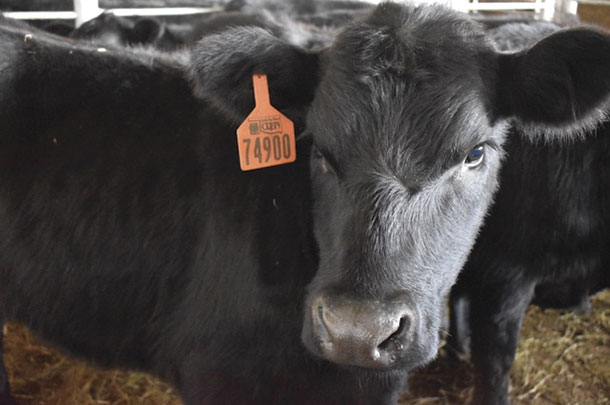He prides himself on his herd’s genetics and has a reputation for selling high-quality calves. Lynch completed the Oklahoma Master Cattleman program, conducted by Oklahoma State University, and is Beef Quality Assurance (BQA) certified.
After learning about preconditioned calf sales, Lynch realized marketing on reputation alone couldn’t recoup the costs of his established herd health program. Lynch hasn’t changed his herd health program; he is just aligning his marketing plan in a way to realize more profits for his efforts. Lynch says, “Now I market all my calves through the Oklahoma Quality Beef Network (OQBN).” The OQBN is a collaboration between Oklahoma Cooperative Extension Service and the Oklahoma Cattleman’s Association, designed to improve access to value-added marketing opportunities.
A typical preconditioned process-verified calf sale includes a method to certify health management, age and source verification, individual animal identification, traceability and access to value-added markets. In states like Oklahoma and Arkansas, the cooperative extension service is providing leadership, education, structure and verification for preconditioned calf sales. In other states like Texas and Alabama, extension provides education and support but takes a more hands-off approach to the organization of preconditioned sales.
Rick Machen, professor, King Ranch Institute for Ranch Management at Texas A&M University – Kingsville, says, “If you’re going to go to the trouble of preconditioning calves and do everything right, you have got to have a marketing plan in place before you go down that path, otherwise the chances of you getting paid for your efforts are slim to none.”
The premiums for preconditioning programs can be realized through organized preconditioned process verified feeder calf sales, video auctions or direct sales off the farm. However, it is unlikely your efforts will be rewarded at a local sale barn. Machen says, “That’s one thing we’ve taught producers from the get-go in the VAC-45 Extension program. We told producers, ‘If you’re going to go to the trouble to precondition your calves and develop a preventative herd health plan, you’ve got to take those cattle to either video, direct sales in the country or, if you take them to a sale barn, you’ve got to take them where the buyers are willing to pay more for them.’”
Shane Gadberry, professor, University of Arkansas Animal Science, is organizer of the GoGreen preconditioned calf sales. The name is a reference to the green eartags certified Arkansas preconditioned calves have.
Gadberry says, “In Arkansas, there are eight markets reported by the USDA-AMS. Some of these markets offer special preconditioned calf sales, while others recognize preconditioned cattle as part of their regular sale. What we’ve seen this fall is bulls being discounted 4 dollars per hundredweight compared to steers at 300 pounds but, at 600 pounds, that discount increased to 14 dollars per hundredweight.
USDA medium- and large-frame, number one muscled calves averaged 12 dollars per hundredweight more than medium- and large-frame, number two muscled calves. If we look at just the steers and heifers, and whether or not they were categorized as value-added or not, the value-added difference was an additional 8 dollars and 52 cents per hundredweight or 52 dollars per calf.”
“The problem with some of the lower margins at the preconditioned sales is the genetics of the calves,” Mike McClintock, county extension agent, Boone County, Arkansas, says, “Quality is still king. You can put green tags in a frame score three or light number two calf, and they’re not going to bring what a number one calf is going to bring. However, the weaned and verified calves never fail to earn more than their unvaccinated contemporaries.”
Kellie Raper, professor, department of agriculture economics, Oklahoma State University, says, “Our research [from the OQBN sales] has found that, though premiums are not guaranteed, the probability of a positive net return above costs from the Vac-45 program is about 80 percent, and the expected net return ranges from 40 dollars to 80 dollars per head with an average expected net return of about 60 dollars per head.” Raper has developed a budget tool available at oqbn.okstate.edu/calculators that producers can use to better ascertain the costs and potential benefits to their operation.

According to Gadberry, cattle buyers expect morbidity to be lower and recovery quicker in preconditioned cattle, and good vaccine management is critical to program integrity. “Buyers like as many days as you can give them between weaning and marketing your calves, but 45 days is a minimum. Data shows that cattle that weigh more have less morbidity, and weight is a function of diet and age. It is important to watch market conditions and feed costs. You don’t want to get calves too fleshy or too big for your market either by adding days to their age.”
McClintock says, “I had a buyer call me back in May, and he’d bought about 300 head at our January GoGreen sale and just wanted to let me know that he did not have to pull and treat a single calf. He said it was the first time he could drive out in fresh calves with a feed truck, and they all came up to eat, and he was really impressed. He came back to our August sale and bought a bunch more.”
“Organized preconditioned sales allow producers to market calves with similar calves in larger numbers than if they were to sell them on their own,” Jeff Robe, Oklahoma State University-OQBN coordinator says. “The opportunity to sell with larger lots of like calves tends to increase premiums. Buyers need to fill trucks, and the availability of larger numbers of high-quality calves are more economical for everyone.”
Producers interested in getting started can reach out to extension professionals to learn what sales are available in their area and the requirements for participation. Machen says, “The first thing I would tell producers is: Develop your marketing plan before you implement your animal management plan. Because where you choose to market calves is going to have an impact on what your management plans are going to be.”
It’s important to remember overhead costs; herd health is a fixed cost, but feed and freight are variable and can dramatically decrease profits. Machen says, “You need to consider what the freight’s going to cost you to get them to the market. If you’re preconditioning a truck load or more, you can put those on a video, and then the freight is the buyer’s issue to worry about and you deliver them right there off the ranch.”
In the end, preconditioned calves improve every step of the beef supply chain. Austin and Kayla Pratt live near Harrison, Arkansas, where they have 200 commercial cows with Angus bulls. They marketed their calves at the first GoGreen preconditioned calf sale in Boone County, Arkansas. The Pratts, like the Lynches, are motivated by more than money, Kayla says. “While I’m sure finances are the main driving force behind why so many producers decide to precondition their calves, for me personally pride is a close second. As much time as we put into our farm and our animals, we want to know that we’ve prepared them for the next phase of production.” ![]()
PHOTO 1: Producers who precondition their calves likely won’t be rewarded for their efforts unless they do their own marketing or take them to a sale where buyers are willing to pay more. Photo by Mike Dixon.
PHOTO 2: A preconditioned calf at OQBN sale in Blackwell, Oklahoma. Photo by Melissa Beck.
Melissa Beck is a freelance writer based in Stillwater, Oklahoma. Email Melissa Beck.








